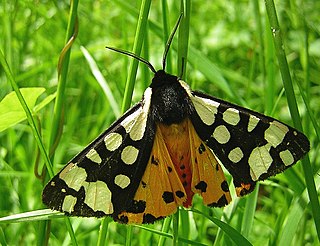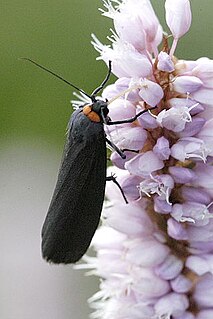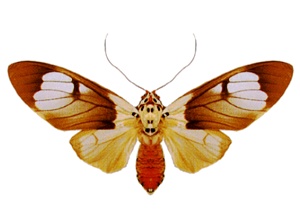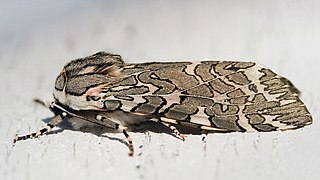
The Arctiinae are a large and diverse subfamily of moths, with around 11,000 species found all over the world, including 6,000 neotropical species. This group includes the groups commonly known as tiger moths, which usually have bright colours, footmen, which are usually much drabber, lichen moths, and wasp moths. Many species have "hairy" caterpillars that are popularly known as woolly bears or woolly worms. The scientific name of this subfamily refers to this hairiness. Some species within the Arctiinae have the word “tussock” in their common name due to people misidentifying them as members of the Lymantriinae based on the characteristics of the larvae.

The Arctiini are a tribe of tiger moths in the family Erebidae.

The Phaegopterina are a subtribe of tiger moths in the Arctiini tribe, which is a part of the family Erebidae.

The Callimorphina are a subtribe of woolly bear moths in the family Erebidae. The subtribe was described by Francis Walker in 1865. Many of these moths are easily confused with butterflies, being quite brightly colored and somewhat diurnal. Their antennae are not thickened into "clubs", which is a typical characteristic of butterflies.

The Arctiina are a subtribe of moths in the family Erebidae.

The Ctenuchina are a subtribe of moths in the family Erebidae.

The Lithosiini are a tribe of lichen moths in the family Erebidae.

Amerila is a genus of moth in the subfamily Arctiinae. A number of species in this genus have a special defence mechanism when they are in their adult stage. When disturbed, they exude a frothy yellow fluid from glands beside the eyes, while making a sizzling noise to ward off their attacker. Similar behaviour has been observed in fertilised females of the North-American moth Utetheisa ornatrix.

Arachnis is a genus of moth in the subfamily Arctiinae, subfamily Arctiinae.
Creatonotos is a genus of tiger moths in the family Erebidae. The moths in the genus are found in the Afrotropics, South and East Asia, Sundaland and Australia.

Dysschema is a genus of tiger moths in the family Erebidae. The genus contains some of the more showy moths of the southwestern United States.
Haemanota is a genus of arctiine tussock moths in the family Erebidae.
Mantala is a genus of moths in the subfamily Arctiinae. It contains the single species Mantala tineoides, which is found on Borneo. The habitat consists of lowland and lower montane forests.

Metarctia is a genus of moth in the family Erebidae, subfamily of Arctiinae.
Teracotona is a genus of moths in the family Erebidae from the Afrotropics.

Virbia is a genus of tiger moths in the family Erebidae.

Dioptinae is a subfamily of the moth family Notodontidae.

The Erebidae are a family of moths in the superfamily Noctuoidea. The family is among the largest families of moths by species count and contains a wide variety of well-known macromoth groups. The family includes the underwings (Catocala); litter moths (Herminiinae); tiger, lichen, and wasp moths (Arctiinae); tussock moths (Lymantriinae), including the arctic woolly bear moth ; piercing moths ; micronoctuoid moths (Micronoctuini); snout moths (Hypeninae); and zales, though many of these common names can also refer to moths outside the Erebidae. Some of the erebid moths are called owlets.

The Amerilini are a tribe of woolly bear moths (Arctiidae) in the subfamily Arctiinae. They are sometimes incorrectly merged into the Phaegopterini, but morphologically the tribe is related to Callimorphini. The elder name Rhodogastriini Kiriakoff, 1950 was based on incorrectly determined genus Rhodogastria.

The Pericopina is a subtribe of tiger moths in the family Erebidae.

















